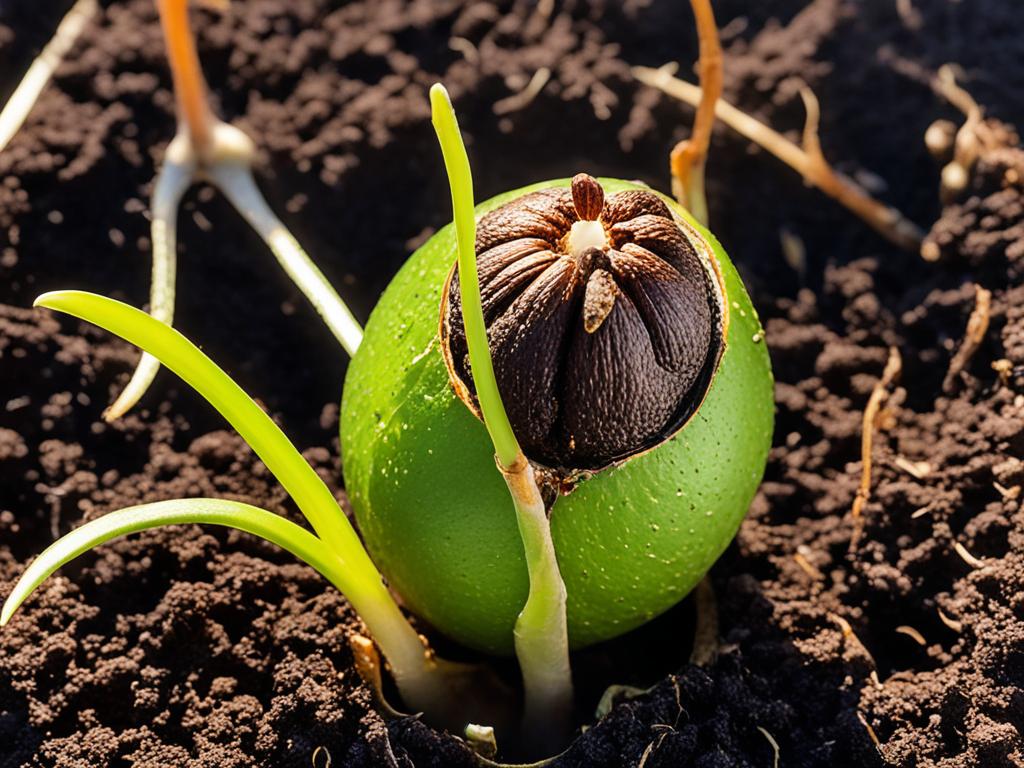Growing avocados from seed is a rewarding DIY project. It can give you a steady supply of fresh, homegrown avocados. This guide will take you through the process, from picking and preparing the seed to caring for the plant and increasing fruit production.
If you live in a warm climate, you can transplant the tree outside. Or, you can grow it as a houseplant. I’ll share everything you need to know about growing an avocado from a pit to produce.
Avocado propagation is fun and rewarding. It lets you grow your own avocado tree at home. From sprouting the seed to harvesting the fruit, this guide covers it all. You’ll learn the best ways for germination, transplanting, and caring for your avocado tree. It’s perfect for both seasoned gardeners and beginners in avocado cultivation.
Whether you’re growing avocados as a hobby or for a steady supply, this DIY guide is for you. It covers everything from planting to caring for your avocado tree. With this knowledge, you’ll be confident in growing your own avocados from seed. Get ready to enjoy the fruits of your labor!
Introduction
Growing avocados from seed is a fun and rewarding project. It lets you have a steady supply of fresh, homegrown avocados. This hobby is not only engaging but also offers many benefits.
The Benefits of Growing Avocados from Seed
- Cost-effective: Growing avocados from seed saves money compared to buying a mature tree.
- Sense of accomplishment: Growing an avocado tree from a seed is very satisfying.
- Potential for unique varieties: You might get new and better avocado varieties from your tree.
- Endless supply of avocados: A healthy tree gives you lots of fresh, nutritious avocados for your recipes.
Overview of the Process
Growing avocados from seed has several steps. First, pick a healthy seed. Then, germinate it, transplant the seedling, and care for the plant as it grows. By following these steps, you can grow your own avocado tree and enjoy its fruits for years.
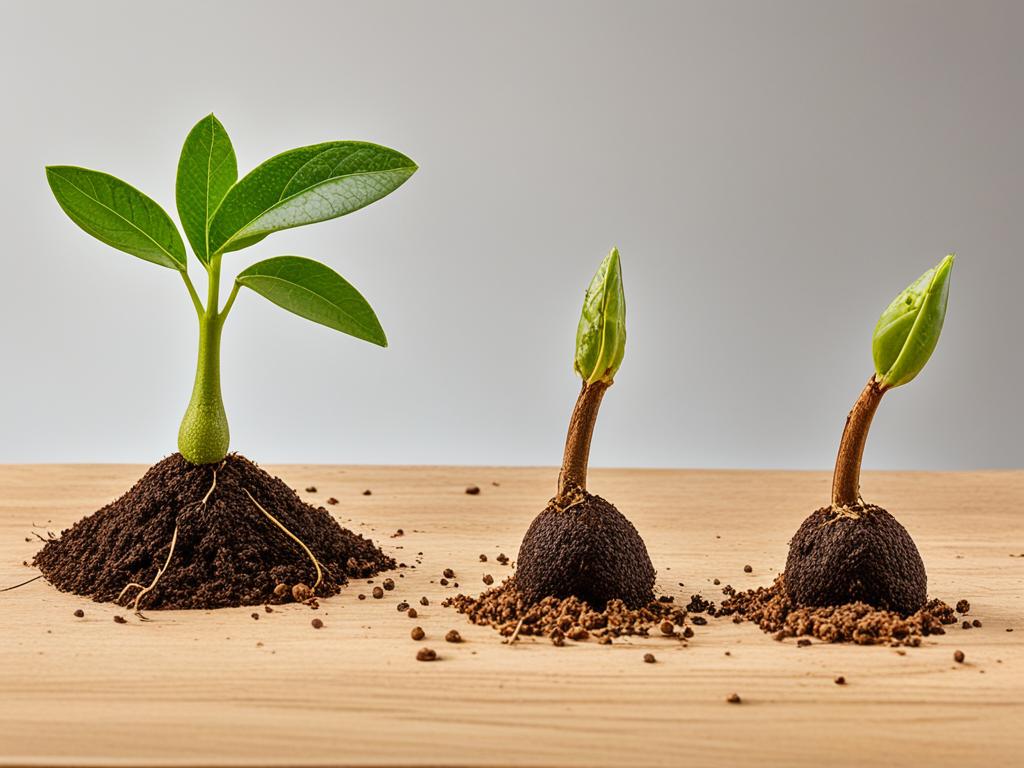
Avocado pits should be planted quickly or kept damp for best results. Growing seedlings in pots works better than sprouting in water indoors. With proper care, your avocado tree can start producing fruit in 4-5 years. This gives you a steady supply of this healthy, versatile fruit.
Selecting and Preparing the Avocado Seed
Starting to grow your own avocado from seed is exciting. First, pick a seed that feels heavy for its size and looks good. Make sure it has no marks or soft parts. This way, you start with a strong seed that will likely do well.
Then, it’s time to remove the seed from the fruit. Carefully take out the seed without hurting it. Wash it under cool water to get rid of any avocado bits, and you’re set to start germinating.
Choosing a Healthy Avocado Seed
- Select an avocado that is heavy for its size and has no visible blemishes or soft spots.
- Avocado trees grown from seed can take 5-13 years to bear fruit, and in northern climates, they are less likely to produce fruit.
- Avocado trees are shallow-rooted and do not like being disturbed once established, so planting in one spot is advisable.
Removing the Seed from the Fruit
- Carefully extract the seed from the avocado, taking care not to damage it.
- Rinse the seed under cool water to remove any remaining avocado flesh.
- The seed is now ready to begin the germination process.
By following these steps, you’ll be well on your way to successfully growing your own avocado from seed. With the right care and attention, your homegrown avocado tree could one day provide you with a bountiful harvest of delicious, nutrient-rich fruit.
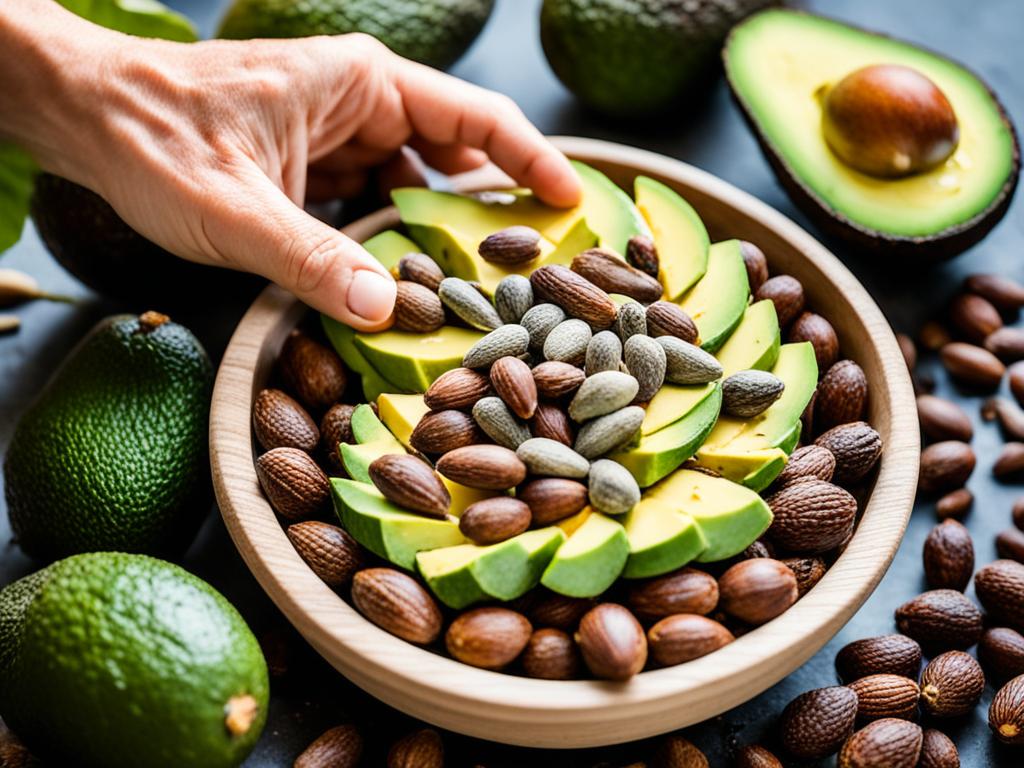
The Water Germination Method
The water method is a popular way to grow an avocado seed. It lets you watch the seed grow and make sure it has the best conditions. This method is easy to follow and effective.
Setting Up the Germination Container
You’ll need a clear glass or jar, some toothpicks, and clean water to start. Put three toothpicks around the seed’s middle, keeping them evenly spaced. These toothpicks will hold the seed over the water.
Fill the container with water, making sure the seed’s bottom half is under water. This setup is perfect for the seed to sprout and grow.
Caring for the Seed During Germination
- Keep the water level topped up, ensuring the seed remains partially submerged as it begins to sprout.
- Place the container in a warm, bright location, out of direct sunlight.
- Monitor the seed closely, as it should begin to sprout roots and a stem within 2-6 weeks.
When the roots are about 3 inches long and the stem starts to come out, your avocado seed is ready for soil. With the right care and conditions, you can grow your own avocado plant from scratch!
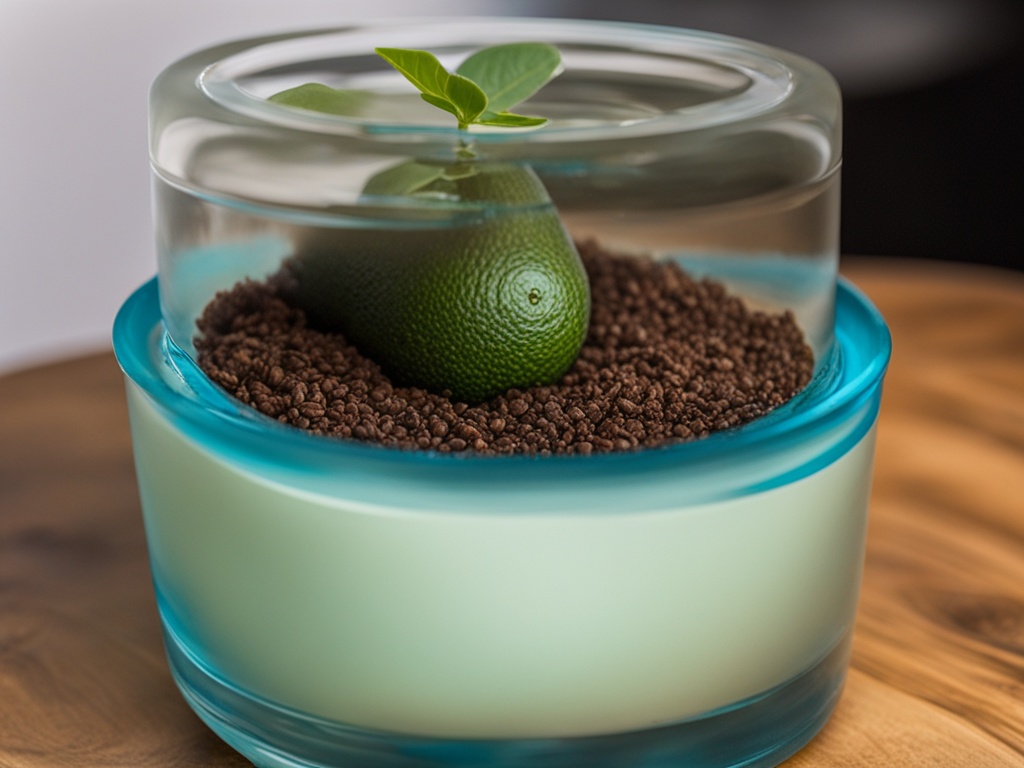
The Soil Germination Method
Looking to grow an avocado tree from seed? The soil germination method is a great choice. It means planting the seed in a potting mix-filled container. This lets the seed sprout and grow its roots in the soil.
First, pick a potting mix that drains well and fill a 4-6 inch wide pot or container. Put the avocado seed in with the pointed end down and the flat end a bit above the soil. Water the soil lightly to keep it moist, but don’t overdo it.
- The germination process takes 2-4 weeks for the seed to crack open and show initial root formation.
- Once the root is about 1 inch long, move the seedling to a container filled with water to grow further.
- The stem of the avocado plant usually sprouts after 1-2 weeks of root development.
It’s important where you put the container. Place it in a warm, bright spot, but not in direct sunlight. Check the soil moisture often and water when the top inch feels dry. With patience and care, your avocado seed should sprout and grow into a healthy plant.
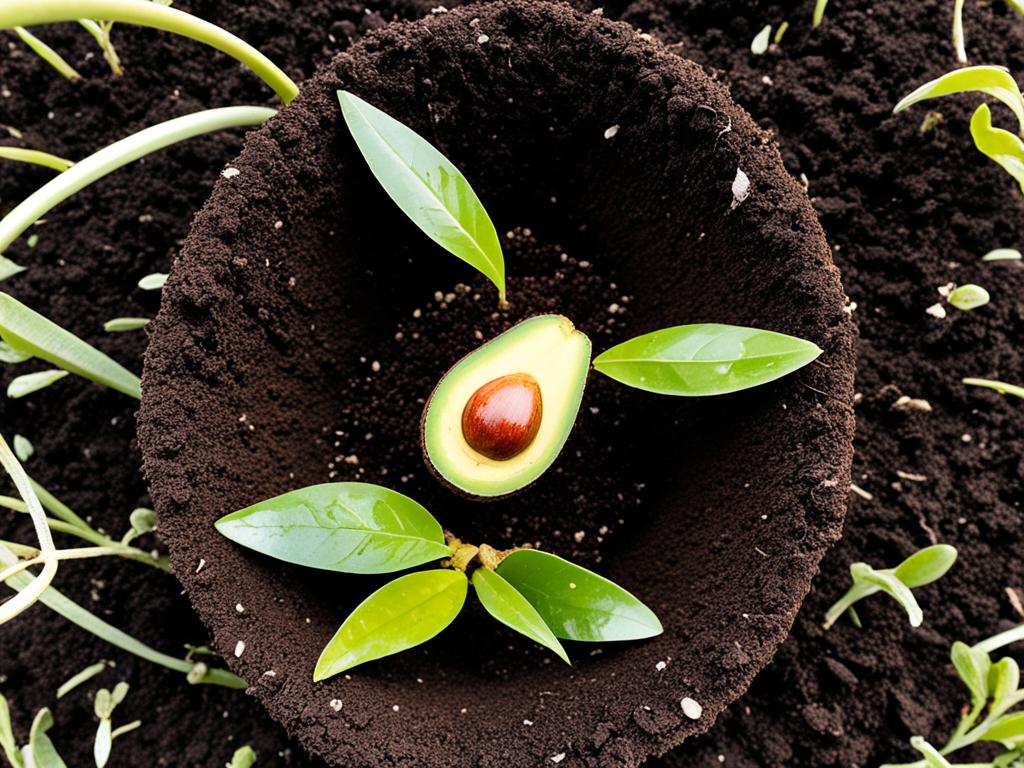
The water germination method is easy and works well, but the soil method is also a good choice. By following these steps, you’re on your way to growing your own avocado tree from scratch!
Transplanting the Seedling
When your avocado seed sprouts and grows a good-sized stem and roots, it’s time to move it to a bigger pot. Getting the potting mix right and moving the seedling carefully are key for a smooth move. This helps your avocado plant keep growing well.
Preparing the Potting Mix
For your avocado seedling, pick a potting mix that drains well. You can use a mix you make yourself or a store-bought one made for avocado plants. The mix should be light, airy, and have things like pumice, perlite, vermiculite, or coconut coir. These help with drainage and air around the roots.
Transferring the Seedling to a Container
When it’s time to move the seedling, carefully take it out of its old pot or water. Don’t hurt the roots. Put the seedling in its new pot, making sure the roots are covered but the seed is still showing. Water well and put the pot in a warm, sunny spot for it to settle in.
Remember, how you plant the avocado seed matters. The top should face up for leaves to grow, and the bottom should be down for roots. With the right way of moving and caring for your seedling, it will keep growing and give you delicious fruit.
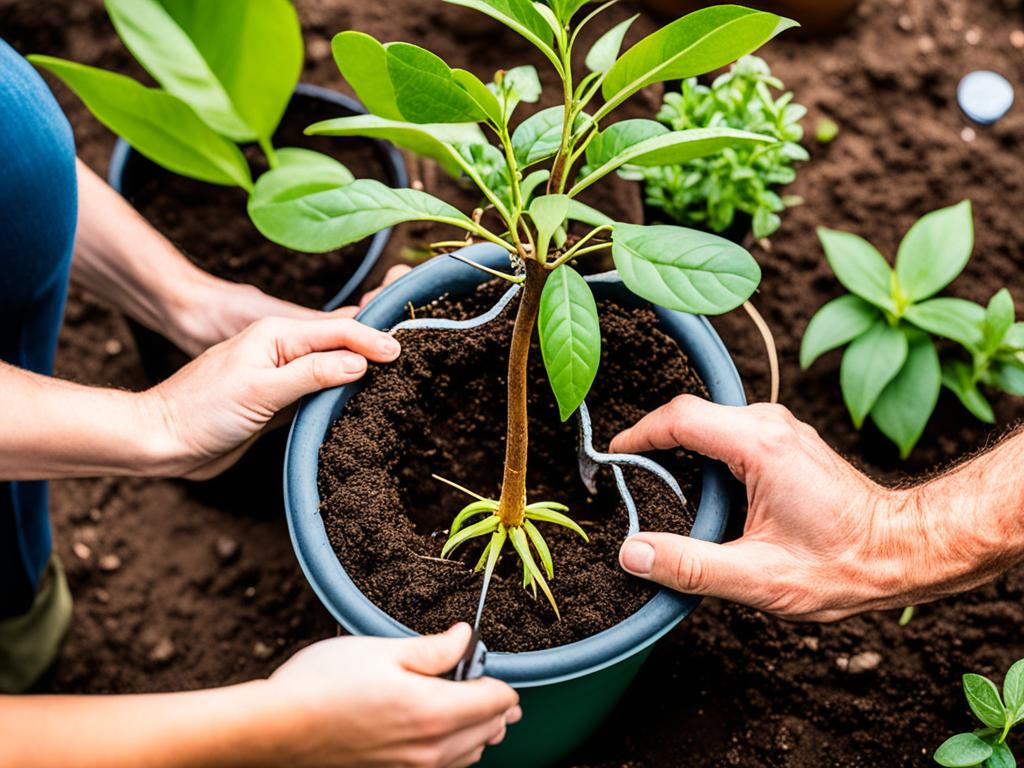
“Transplanting an avocado seedling is a delicate process, but with the right preparation and care, you can ensure a successful transition to a larger container.”
Caring for the Avocado Plant
Taking care of your avocado plant is very rewarding. It’s important to pay attention to its watering and environment. Doing so ensures a healthy plant and lots of avocados.
Watering Requirements
Avocados need soil that’s always moist but not soaked. Water the plant well, then let the soil dry out a bit before watering again. This balance stops root rot and keeps the plant healthy. Water your avocado plant when the top inch of soil feels dry.
Light and Temperature Needs
Avocado plants do best in bright, indirect light. Give your plant at least 6 hours of sunlight daily. Place it in a south or west-facing window. Keep the leaves safe from direct afternoon sun to avoid sunburn.
Also, avocados can’t handle cold. Keep the plant in a warm spot, between 55-85°F. Cold temperatures or frost can really hurt the plant.
Knowing and meeting your avocado plant’s watering, light, and temperature needs helps it grow well. This way, you’ll have a healthy and productive plant.
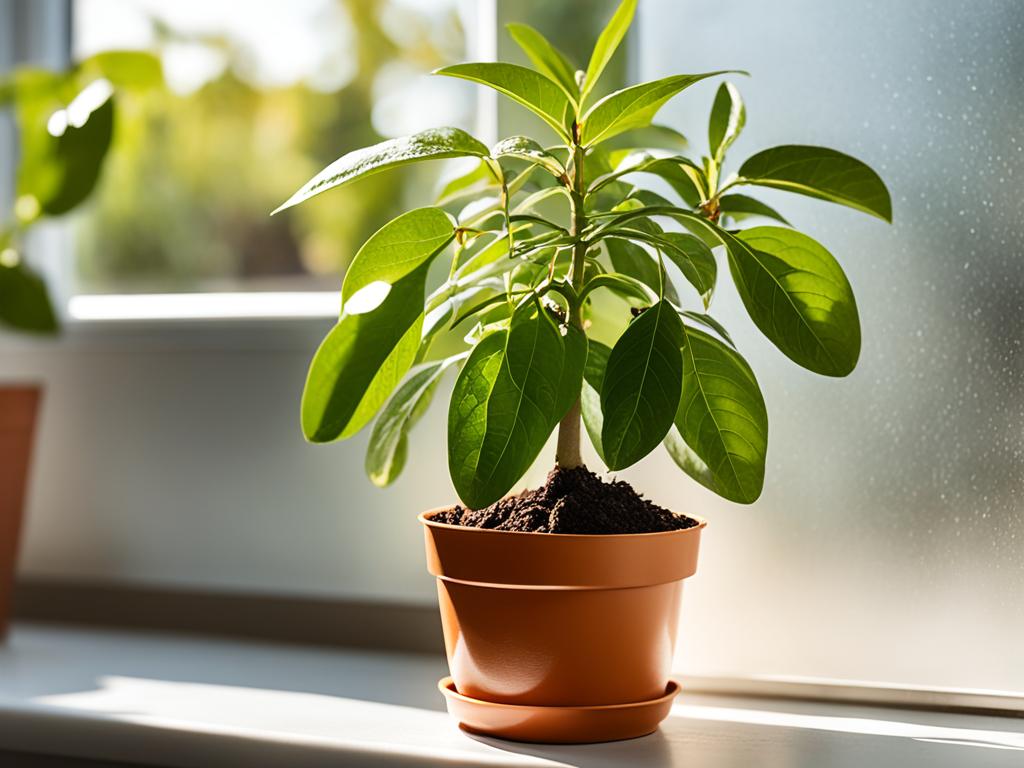
Pruning and Training the Plant
As your avocado plant grows, regular pruning is key. It helps keep its shape and encourages bushy growth. It’s important to know when and how to prune your avocado plant.
When to Prune?
Prune young avocado trees to about 20-30cm (8-12 inches) tall. This encourages new growth, making the trunk thicker and the plant fuller. Spring and summer are the best times to prune for new growth. Wait at least a month after planting before pruning to let the roots settle and avoid weakening them.
For older avocado trees, pruning is still needed but not as much. Cutting them back can make the plant grow more, focusing on new branches and leaves.
How to Prune?
- Use clean, sharp pruning shears to make clean cuts.
- Prune just above healthy leaves, cutting at a slight angle for drainage.
- Remove dead, damaged, or crossing branches for a neat plant.
- Avoid over-pruning to prevent plant stress and slow growth.
By following these pruning tips, your avocado plant will stay healthy and look great for years.
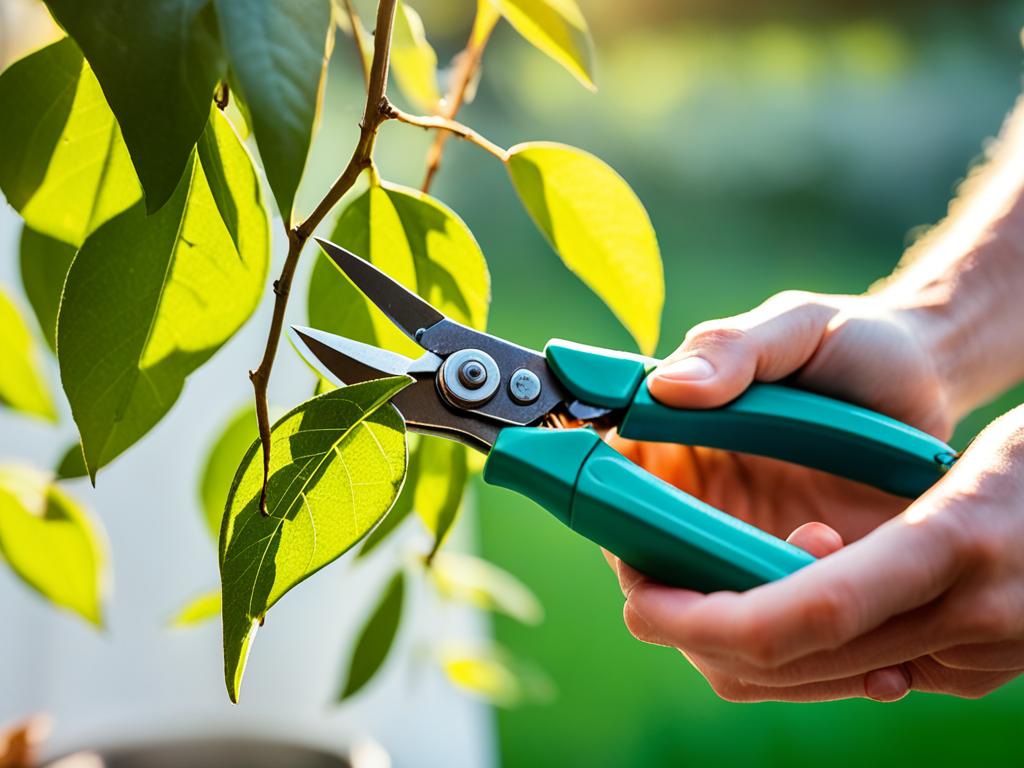
Troubleshooting Common Issues
Growing avocados from seed can be rewarding but comes with challenges. Knowing how to fix these issues can help your plant grow well.
One big problem is when the seed won’t germinate. This might be because the seed is old or damaged, or the conditions aren’t right. To fix this, use a fresh, healthy seed and make sure the germination conditions are perfect.
Another issue is when leaves turn red or yellow. This often means the plant gets too much sun or isn’t getting enough water. Change the plant’s light and water to get the leaves green again.
- Seed failing to germinate: Ensure you’re using a fresh, healthy seed and providing the right temperature and moisture levels during germination.
- Discolored leaves: Red or yellow leaves may indicate too much sun exposure or underwatering. Adjust the plant’s light and watering needs.
- Root rot: Overwatering can lead to root rot, causing the roots to decay. Adjust your watering schedule and ensure the soil has proper drainage.
Root rot is another big problem, usually from too much water. If roots decay, change your watering and make sure the soil drains well.
Watch your avocado plant closely and fix problems fast. This way, you can keep it healthy and grow your own avocados at home.
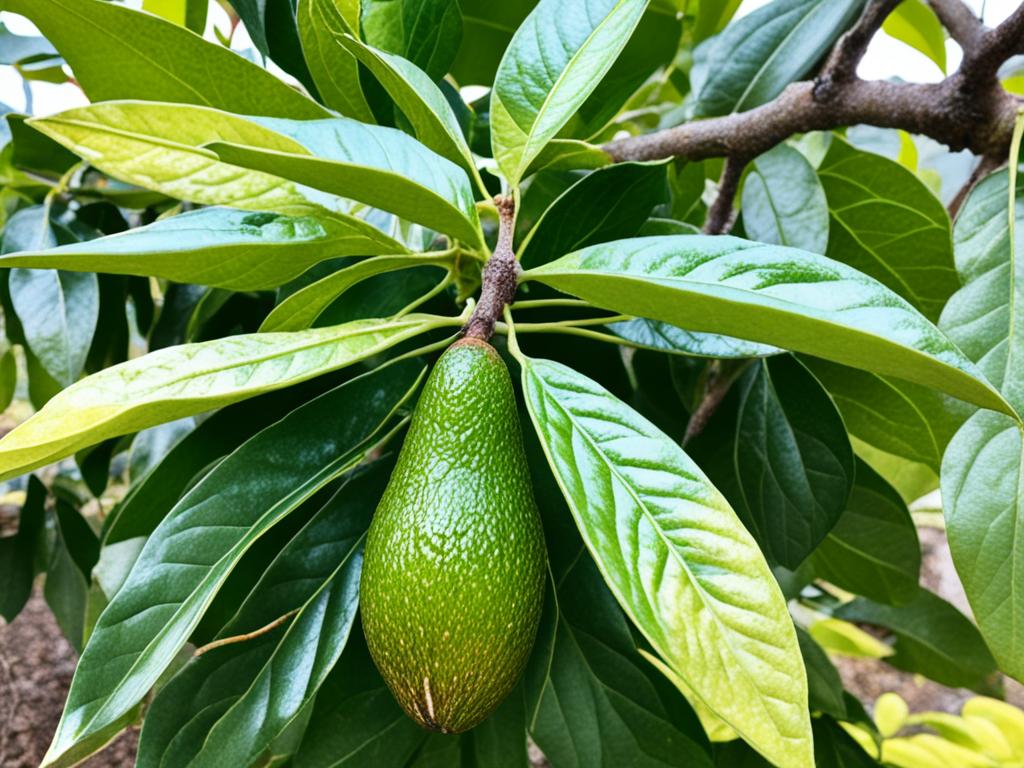
Transplanting Outdoors (For Warm Climates)
If you live in a warm area without harsh winters, you can move your avocado plant outside. Picking the right site selection for outdoor avocado tree and how you plant and establish outdoor avocado tree are key. These steps help your avocado grow well outside.
Site Selection and Preparation
For transplanting avocado plant outdoors, find a spot that gets lots of sun all day. Make sure the soil drains well since avocado trees don’t like wet feet. Stay away from places with strong winds to protect the leaves and branches.
Planting and Establishing the Tree
Dig a hole a bit bigger than the root ball of your avocado plant. Carefully move the plant, being careful with the roots. Fill the hole with soil and water the tree well. Then, add a 2-3 inch layer of organic mulch around the tree, but keep it away from the trunk to avoid rot.
With the right site selection for outdoor avocado tree and planting and establishing outdoor avocado tree, your plant will do great outside. Just remember to water it often and watch for any problems as it gets used to its new spot.
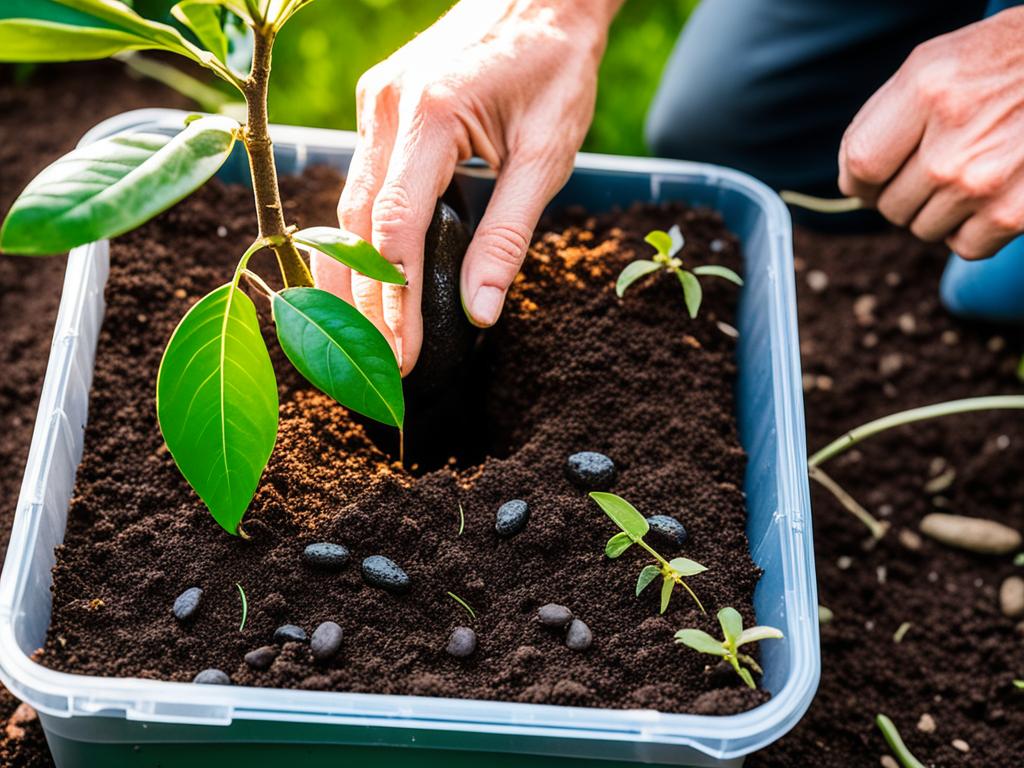
How to grow an avocado from seed?
Growing an avocado from seed is both fascinating and rewarding. It lets you watch a plant grow from its earliest stages. While these trees may not produce the best fruit, they can still be great houseplants or trees in warm areas. Let’s explore the steps to grow an avocado from seed.
Selecting and Preparing the Seed
Start by picking a healthy, ripe avocado and removing its seed. Rinse the seed under water to get rid of any leftover avocado. Then, let it dry completely before moving on.
Germinating the Seed
- There are two ways to get the seed to sprout: water or soil. In water, place the seed with the pointy end down in a glass. Change the water often and wait for it to crack open and grow roots.
- Or, you can put the seed in a pot filled with good potting mix. Keep the soil moist but not too wet, and roots should appear in a few weeks.
Transplanting and Care
When the stem and leaves start to grow, move the seedling to a bigger pot with rich potting mix. Put it in a sunny spot and water it often, letting the soil dry a bit between waters. Trim the plant to help it grow bushy, and feed it every few months to help it grow.
With patience and the right care, your avocado plant will keep growing. You might even get delicious avocados from your own tree. Enjoy watching your seed turn into a thriving plant!

| Germination Method | Advantages | Disadvantages |
|---|---|---|
| Water Germination |
|
|
| Soil Germination |
|
|
“The true secret of happiness lies in taking a genuine interest in all the details of daily life.” – William Morris
Growing an avocado from seed takes time and patience. But with the right steps and care, you can enjoy watching your avocado plant grow from the start.
Maximizing Fruit Production
As your avocado plant grows, getting a lot of avocados comes down to knowing how it pollinates and what nutrients it needs. By understanding these key points, you can help your tree produce lots of fruit.
Avocado Pollination Requirements
Avocado flowers need help from different plants to make fruit. You should have at least two different avocado plants close together. They open and close their flowers over two days, so bees and other insects are key for pollination.
Fertilizing and Pest Management
Feeding your avocado tree the right food is also crucial. Use a balanced 15-15-15 fertilizer with nitrogen, phosphorus, and potassium. Put it on a few times a year, as the package says, to keep your tree healthy.
Also, watch out for pests and diseases. Use things like insecticidal soap or neem oil if you see any problems. This keeps your tree safe and healthy.
| Avocado Cultivation Best Practices | Benefits |
|---|---|
| Ensuring cross-pollination between compatible cultivars | Increased fruit set and production |
| Applying a balanced 15-15-15 fertilizer regularly | Providing essential nutrients for optimal growth and fruit development |
| Implementing effective pest and disease management | Protecting the plant’s health and productivity |
By doing these things, you can get a lot of avocados from your tree. Follow the tips on maximizing avocado fruit production, avocado pollination requirements, and fertilizing and pest management for avocado plants.
“The likelihood of an avocado tree grown from a pit at home producing fruit is around 20%.”
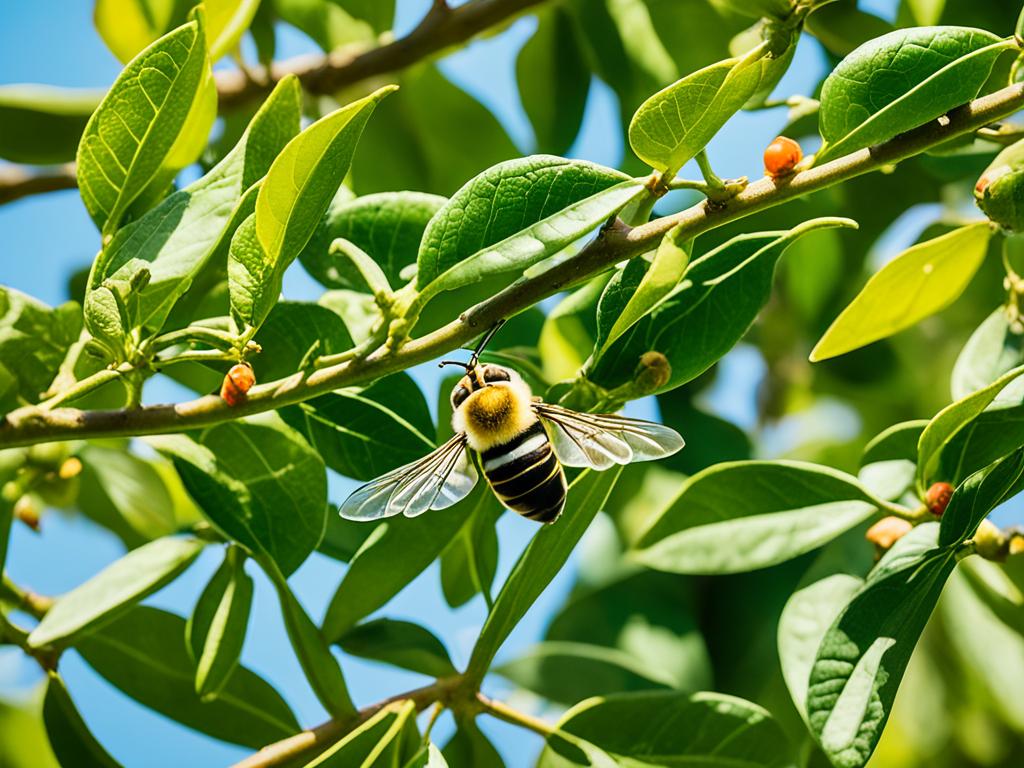
Harvesting and Enjoying Your Avocados
The wait is finally over! After taking care of your avocado plant, it’s time to enjoy the fruits of your labor. Knowing when your avocados are ripe is important for enjoying their creamy, tasty flavor.
Determining When Avocados Are Ripe
Figuring out if avocados are ripe can be a bit tricky. But, there are signs to look for. Gently squeeze the avocado; if it yields slightly, it’s ready. The skin should turn from deep green to a rich, almost black color.
Another way to check is the stem. If the stem comes off easily, your avocado is ripe.
Storing and Using Homegrown Avocados
After harvesting, store your avocados in the fridge to keep them fresh. When you’re ready to use them, let them warm up to room temperature first. You can use them in many dishes, like guacamole or avocado toast. Their fresh taste will show how rewarding your garden work has been.
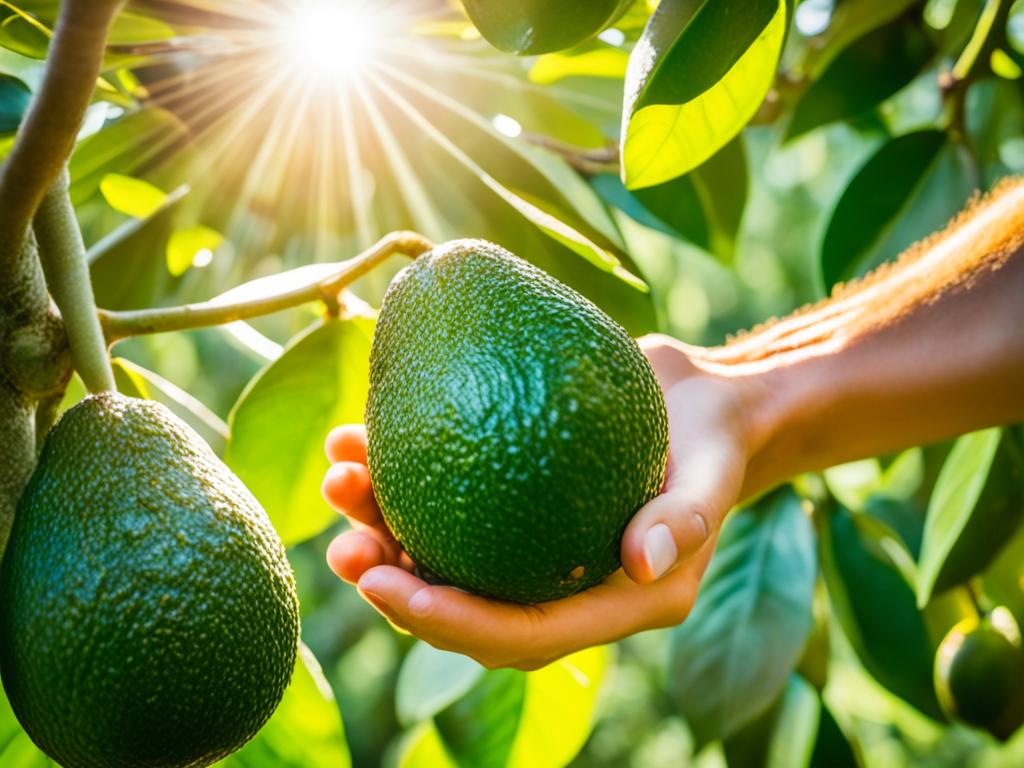
Enjoy the fruits of your labor and be proud of the delicious, healthy avocados you’ve grown. With the right methods, you can have a big harvest. And you can enjoy the many uses of this superfood from your own garden.
Conclusion
Growing an avocado from seed is a rewarding project. It can give you a steady supply of fresh, nutritious avocados. By following the step-by-step guide, you can grow your own avocado plant indoors or outdoors. With care and patience, your tree can thrive and give you lots of fruit for years.
The journey of growing avocados from seed is exciting. You’ll learn about the high success rate of partially submerged seeds and watch the plant grow. It might take a few years for your tree to produce fruit. But the joy of eating your own unique avocados is unmatched.
Looking after an avocado plant has many benefits. It improves indoor air quality, supports local food sources, and offers gardening therapy. Growing avocados from seed is a fulfilling experience. It connects you to nature and rewards your hard work and dedication.
FAQ
What are the benefits of growing avocados from seed?
Growing avocados from seed is a fun DIY project. It gives you fresh, homegrown avocados. It’s a low-cost way to have your own avocado plant, ensuring a steady supply for your recipes.
How do I select and prepare the avocado seed?
Choose an avocado that feels heavy for its size and looks good. Remove the seed carefully without damaging it. Rinse the seed to get rid of any avocado flesh, then start germinating.
What are the different methods for germinating an avocado seed?
There are two ways to germinate an avocado seed: the water method and the soil method. The water method uses a glass or jar of water. The soil method plants the seed in a potting mix.
How do I transplant the avocado seedling?
When the seedling has a good stem and roots, it’s time to move it. Prepare a potting mix that drains well. Carefully take the seedling from its current spot or water. Plant it in the new pot, covering the roots but leaving the seed top exposed.
What are the care requirements for an avocado plant?
Avocados need soil that stays moist but isn’t too wet. They love bright, indirect light and can’t handle the cold. Keep the plant in a warm spot, between 55-85°F, and watch for stress or sunburn on the leaves.
How do I prune and train the avocado plant?
Trim the stem to 3 inches when it’s 6 inches tall to help roots grow. Prune every 6 inches to make the plant fuller. Use clean, sharp shears and cut just above healthy leaves.
Can I transplant my avocado plant outdoors?
If your area doesn’t freeze, you can move your avocado plant outside. Pick a spot with good soil and lots of sun. Dig a hole and carefully move the plant, being careful with the roots.
How do I maximize the fruit production of my avocado plant?
Make sure the plant gets the right nutrients with regular fertilizers. Protect it from pests and diseases to help it produce more fruit. Cross-pollination is also key for avocado flowers.
How do I know when my avocados are ready to harvest?
Learn how to tell when your avocados are ripe. Once picked, store them right and use them in many tasty recipes, like guacamole or avocado toast.
